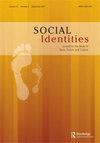寻找宗教:印度查谟和克什米尔贱民身份的形成
IF 0.7
Q3 ETHNIC STUDIES
引用次数: 0
摘要
位于查谟和克什米尔控制线沿线的边境地区Poonch的达利特人属于多宗教的帕哈里民族。1947年印度次大陆的分裂影响了该社区,并使他们越过停火线流离失所。停火线将昔日的庞奇封地一分为二,此后一直是事实上有争议的边界。他们被转移到印度一侧的Poonch,为已经被污名化的社区(也称为Harijans/Bangis)增加了另一层边缘化,因为在分治后的情况下,他们的康复过程未能超越排斥和歧视的叙事。对于庞奇的达利特人来说,这段旅程与在印度其他地方遭受压迫和排斥的达利特不同。达利特人寻求“宗教身份”,在那里他们可以平等存在,他们属于三个不同的宗教派别。通过人种学调查,这项研究在探索达利特人在这里的生活经历的同时,也着眼于牢记分裂和宗教在这里身份演变中的作用。除了Poonch的达利特社区和占主导地位的种姓群体之间不断变化的社区间互动之外,该研究还通过观察一个人作为达利特人是如何存在的,生活在多种身份之间和具有多种身份:宗教身份、更大的帕哈里族身份,这两种身份都处于与边境身份的十字路口,居住在冲突和争端的地区。本文章由计算机程序翻译,如有差异,请以英文原文为准。
In search of a religion: the making of Dalit-Identity in Jammu and Kashmir, India
ABSTRACT The Dalits in Poonch, a borderland district situated along the line of control in Jammu and Kashmir, belong to the multi-religious Pahari-ethnic-group. The partition of the Indian subcontinent in 1947 affected the community and displaced them across the cease-fire line – the boundary that bisected the erstwhile Poonch fiefdom and has since then stood as the de facto disputed border. Their displacement to the Poonch on the Indian side added another layer of marginality to an already stigmatised community (also referred to as Harijans/Bhangis) as the processes of their rehabilitation failed to rise above the narratives of exclusion and discrimination in a post-partition scenario. For the Dalits of Poonch, the journey has been different from the Dalits who have been subjected to oppression and exclusion elsewhere in India. The ethnic-Dalits in quest of ‘a religious identity’ where they can exist as an equal, have belonged within three different religious folds. Through an ethnographic inquiry, the research while exploring the lived experiences of Dalits here also looks at keeping in mind the role of partition and religion in the evolution of identities here. Besides the changing inter-community interactions between the Dalit community and dominant-caste groups in Poonch, the research analysis layers of marginality by looking at how one exists as a Dalit, living between and with multiple identities: religious identities, the larger Pahari-ethnic-identity, both of them at crossroads with the identity of being a borderlander, dwelling in a zone of conflict and dispute.
求助全文
通过发布文献求助,成功后即可免费获取论文全文。
去求助
来源期刊

Social Identities
ETHNIC STUDIES-
CiteScore
2.00
自引率
0.00%
发文量
22
期刊介绍:
Recent years have witnessed considerable worldwide changes concerning social identities such as race, nation and ethnicity, as well as the emergence of new forms of racism and nationalism as discriminatory exclusions. Social Identities aims to furnish an interdisciplinary and international focal point for theorizing issues at the interface of social identities. The journal is especially concerned to address these issues in the context of the transforming political economies and cultures of postmodern and postcolonial conditions. Social Identities is intended as a forum for contesting ideas and debates concerning the formations of, and transformations in, socially significant identities, their attendant forms of material exclusion and power.
 求助内容:
求助内容: 应助结果提醒方式:
应助结果提醒方式:


